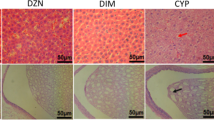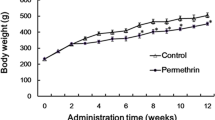Abstract
Background
Rhodopseudomonas palustris had the effect of adsorbing and removing lead ions. Metabolomics is a comprehensive analysis based on several metabolites or biomarkers.
Objective
The paper aimed to investigate the restorative effect and the potential mechanisms of R. palustris in rats with the lead exposure model using 1H-NMR metabolomics.
Results
Nine endogenous metabolites from rat plasma and 13 endogenous metabolites from rat urine were identified as potential biomarkers of the symptoms of lead poisoning. The changes of metabolites levels in the plasma included lower levels of valine, acetoacetate, and N-acetyl-glycoprotein and a higher concentration of lactate, acetate, creatine, threonine, glutamine, and asparagine in model group compared with control group. Furthermore, increased citrate, succinate, dimethylamine, pyruvate, acetoacetate, α-oxoglutarate and asparagine, accompanied by decreased LDL/VLDL, taurine, creatinine, glucose and hippurate levels were observed in the model group compared with the control group in the urine. Biochemical parameters and histopathology examination dovetailed well with the metabolomics data. Treatment with R. palustris at a certain degree returned the levels of these metabolites to normal levels. Plasma and urine metabolomic analysis showed changes associated with energy metabolism, amino acids and fatty acid metabolism of lead exposure rats.
Conclusion
The effects of removing lead ions of R. palustris in rats with lead exposure were confirmed. This research demonstrated that 1H-NMR-based metabolomics was a promising tool to identify potential biomarkers and unravel protective effect mechanisms of R. palustris in lead poisoning rats.





Similar content being viewed by others
Data availability statement
The data presented in this study are available on request from the corresponding author.
References
Al-Neamy FR, Almehdi AM, Alwash R, Pasha MA, Ibrahim A, Bener A (2001) Occupational lead exposure and amino acid profiles and liver function tests in industrial workers. Int J Environ Health Res 11(2):181–188
Bai H, Zhang Z, Yang G (2006) Studies on removal and transformation mechanism of lead by Rhodobacter sphaeroides. Acta Sci Circum 26:1809–1814 (in Chinese)
Bai HJ, Zhang ZM, Yang GE, Li BZ (2008) Bioremediation of cadmium by growing Rhodobacter sphaeroides: kinetic characteristic and mechanism studies. Bioresour Technol 99:7716–7722
Balasubramanian B, Meyyazhagan A, Chinnappan AJ, Alagamuthu KK, Shanmugam S, Al-Dhabi NA et al (2020) Occupational health hazards on workers exposure to lead (Pb): A genotoxicity analysis. J Infect Public Health 13(4):527–531
Cho DH, Kim EY (2003) Characterization of Pb2+ biosorption from aqueous solution by Rhodotorula glutinis. Bioprocess Biosyst Eng 25:271–277
Choi SB, Yun YS (2004) Lead biosorption by waste biomass of Corynebacterium glutamicum generated from lysine fermentation process. Biotechnol Lett 26:331–336
Choi HP, Hong JW, Rhee KH, Sung HC (2004) Cloning, expression, and characterization of 5-aminolevulinic acid synthase from Rhodopseudomonas palustris KUGB306. FEMS Microbiol Lett 236:175–181
Dai Y, Li Z, Xue L, Dou C, Zhou Y, Zhang L et al (2010) Metabolomics study on the anti-depression effect of xiaoyaosan on rat model of chronic unpredictable mild stress. J Ethnopharmacol 128:482–489
Flora SJS, Kumar P (1993) Biochemical and immunotoxicological evaluation of metal chelating drugs in rats. Drug Invest 5:269–273
Gargouri M, Hamed H, Akrouti A, Christian M, Ksouri R, El Feki A (2017) Immunomodulatory and antioxidant protective effect of Sarcocornia perennis L. (swamp fire) in lead intoxicated rat. Toxicol Mech Methods 27(9):697–706
Geret F, Serafim A, Barreira L, Bebianno MJ (2002) Response of antioxidant systems to copper in the gills of the clam Ruditapes decussates. Mar Environ Res 54:413–417
Gonzalez E, van Liempd S, Conde-Vancells J, Gutierrez-de Juan V, Perez-Cormenzana M, Mayo R et al (2012) Serum UPLC-MS/MS metabolic profiling in an experimental model for acute-liver injury reveals potential biomarkers for hepatotoxicity. Metabolomics 8(6):997–1011
He Q, Tang H, Ren P, Kong X, Wu G, Yin Y et al (2011) Dietary supplementation with l-arginine partially counteracts serum metabonome induced by weaning stress in piglets. J Proteome Res 10:5214–5221
Hong CD, Hanenson IB, Lerner S, Hammond PB, Pesce AJ, Pollak VE (1980) Occupational exposure to lead: effects on renal function. Kidney Int 18(4):489–494
Huang CF, Liu SH, Lin-Shiau SY (2007) Neurotoxicological effects of cinnabar (a Chinese mineral medicine, HgS) in mice. J Appl Toxicol 224:192–201
Huang YS, Wang SH, Chen SM, Lee JA (2018) Metabolic profiling of metformin treatment for low-level Pb-induced nephrotoxicity in rat urine. Sci Rep 8(1):14587
Kaczyńska K, Walski M, Szereda-Przestaszewska M (2013) Long-term ultrastructural indices of lead intoxication in pulmonary tissue of the rat. Microsc Microanal 19(6):1410–1415
Lei R, Wu C, Yang B, Ma H, Shi C, Wang Q et al (2008) Integrated metabolomic analysis of the nano-sized copper particle-induced hepatotoxicity and nephrotoxicity in rats: a rapid in vivo screening method for nanotoxicity. Toxicol Appl Pharmacol 232:292–301
Lewis GF, Rader DJ (2005) New insights into the regulation of HDL metabolism and reverse cholesterol transport. Circ Res 96:1221–1232
Li XJ, Chen XQ, Gan YJ, Pan RH, Zheng YY, Wei GM (2007) The relationship between exposure dose and time effect of blood lead and urine lead in the preventive lead excretion rat model. Occup Health 17:1490–1492 (in Chinese)
Liang YH, Liu YN, Zheng QH, Yang F, Zhang ZP, Yang GE (2015) Effects of Rhodopseudomonas marsh culture solution on lead poisoning in urine, blood and feces in rats. Chin J Microecol 27(08):886–889 (in Chinese)
Lindon JC, Nicholson JK, Everett JR (1999) NMR spectroscopy of biofluid. Annu Rep NMR Spectrosc 38:1–88
Liu HP (2021) Study on the probiotic properties of Rhodopseudomonas marsh and its effects on intestinal microbes in healthy mice. Shanxi Medical University (in Chinese)
Liu L, Aa J, Wang G, Yan B, Zhang Y, Wang X et al (2010) Differences in metabolite profile between blood plasma and serum. Anal Biochem 406:105–112
Maddox RW, Carson DS, Barnes CL (1998) Estrogens and postmenopausal women. U.S Pharmacist 23:141–150
Matozzo V, Tomei A, Marin MG (2005) Acetylcholinesterase as a biomarker of exposure to neurotoxic compounds in the clam Tapes philippinarum from the Lagoon of Venice. Mar Pollut Bull 50:1686–1693
Patil AJ et al (2007) Occupational lead exposure in battery manufacturing workers, silver jewelry workers, and spray painters in Western Maharashtra (India): effect on liver and kidney function. J Basic Clin Physiol Pharmacol 18:87–100
Platell C, Kong SE, McCauley R, Hall JC (2000) Branched-chain amino acids. J Gastroenterol Hepatol 15:706–717
Qiao ZY, Li CZ, Zheng Z, Yan PL, Wei T, Hua YJ et al (2020) Research progress on toxicity of lead and its application in treatment. Chin J Toxicol 34(05):416–420 (in Chinese)
Qin J, Rosen BP, Zhang Y, Wang G, Franke S, Rensing C (2006) Arsenic detoxification and evolution of trimethylarsine gas by a microbialarsenite S-adenosylmethionine methyltransferase. Proc Natl Acad Sci USA 103(7):2075–2080
Quan YL, Ou XB, Dai J, Li HY, Wang Y, Hao BQ (2012) Effect of heavy metal stress culture on the growth of Rhodopseudomonas marsh. J Southwest Univ National (Nat Sci Ed) 38(04):570–573
Sasaki K, Morikawa H, Kisibe T, Takeno K, Mikami A, Harada T et al (2013) Simultaneous removal of cesium and strontium using a photosynthetic bacterium, Rhodobacter sphaeroides SSI immobilized on porous ceramic made from waste glass. Adv Biosci Biotechnol 4:6–13
Shi B, Tian J, Xiang H, Guo X, Zhang L, Du G et al (2013) A 1H-NMR plasma metabonomic study of acute and chronic stress models of depression in rats. Behav Brain Res 241:86–91
Steiger S, Mazet A, Sandmann G (2003) Heterologous expression, purification, and enzymatic characterization of the acyclic carotenoid 1,2-hydratase from Rubrivivax gelatinosus. Arch Biochem Biophys 414:51–58
Tanskul S, Oda K, Oyama H, Noparatnaraporn N, Tsunemi M, Takada K (2003) Substrate specificity of alkaline serine proteinase isolated from photosynthetic bacterium, Rubrivivax gelatinosus KDDS1. Biochem Biophys Res Commun 309:547–551
Tian JS, Shi BY, Xiang H, Gao S, Qin XM, Du GH (2013) 1H-NMR-based metabonomic studies on the anti-depressant effect of genipin in the chronic unpredictable mild stress rat model. PLoS ONE 8:1–11
Tietz NW, Shuey DF (1986) Reference intervals for alkaline phosphatase activity determined by the IFCC and AACC reference methods. Clin Chem 32:1593–1594
Tokar EJ, Diwan BA, Waalkes MP (2010) Early life inorganic lead exposure induces testicular teratoma and renal and urinary bladder preneoplasia in adult metallothionein-knockout mice but not in wild type mice. Toxicology 276(1):5–10
Tyagi R, Rana P, Khan AR, Bhatnagar D, Devi MM, Chaturvedi S et al (2010) Study of acute biochemical effects of thallium toxicity in mouse urine by NMR spectroscopy. J Appl Toxicol 31:663–667
Tyagi R, Rana P, Gupta M, Bhatnagar D, Srivastava S, Roy R et al (2014) 1H-NMR spectroscopic analysis detects metabolic disturbances in rat urine on acute exposure to heavy metal tungsten alloybased metals salt. Chem Biol Interact 211:20–28
van Wijngaarden E, Dosemeci M (2016) Brain cancer mortality and potential occupational exposure to lead: findings from the national longitudinal mortality study 1979–1989. Int J Cancer 119:1136–1144
Wang H, Bai J, Chen G, Li W, Xiang R, Su G et al (2013) A metabolic profiling analysis of the acute hepatotoxicity and nephrotoxicity of Zhusha Anshen Wan compared with cinnabar in rats using 1H-NMR spectroscopy. J Ethnopharmacol 146:572–580
Zhang Y, Li Q, Liu X, Zhu H, Song A, Jiao J (2013a) Antioxidant and micronutrient-rich milk formula reduces lead poisoning and related oxidative damage in lead-exposed mice. Food Chem Toxicol 57:201–208
Zhang S, Myracle A, Xiao K, Yan P, Ye T, Ferruzzi M et al (2013b) Metabolic profiling of green tea treatments in Zucker diabetic rats using 1H-NMR. J Nutr Food Sci 3:239
Zhao C, Zhang Y, Chan Z, Chen S, Yang S (2015) Insights into arsenic multi-operons expression and resistance mechanisms in Rhodopseudomonas palustris CGA009. Front Microbiol 6:986
Zou Z, Han B, Gong M, Wang S, Liang S (2014) NMR-based metabonomic studies on stomach heat and cold syndromes and intervention effects of the corresponding formulas. Evid-Based Complement Altern Med
Acknowledgements
This work was supported by National Natural Science Foundation of China (Grant Nos. 30672621, 81173473), Taiyuan city science and technology project special talents star project (120247-08), Central Government Guides Local Scientific and Technological Development Fund Projects (YDZX 20201400001443), Shanxi International Science and Technology Cooperation Project (201803D421065), Shanxi Provincial Key Research and Development Project (No. 201903D321083).
Author information
Authors and Affiliations
Contributions
Conceptualization, SC, ZZ, YL, YH, HY, JC, HB and GY; methodology, SC, YL and YH; formal analysis, SC and ZZ; investigation, SC, ZZ, YL, YH, HY, JC, HB and GY; resources, HB and GY; data curation, SC, ZZ, YL, YH; writing—original draft preparation, SC; writing—review and editing, HY and JC, HB and GY; visualization, SC and ZZ; supervision, HB and GY; funding acquisition, HB and GY; All authors have read and agreed to the published version of the manuscript.
Corresponding author
Ethics declarations
Conflict of interest
Shutong Chai, Ziyun Zheng, Yani Liu, Yanhui Liang, Hong Yang, Jie Chen, Hongjuan Bai and Guan-e Yang declare that they have no competing interests.
Ethical approval
All animal handling and experimental protocols conformed to the guidelines stipulated by the institutional animal ethical committee.
Additional information
Publisher's Note
Springer Nature remains neutral with regard to jurisdictional claims in published maps and institutional affiliations.
Supplementary Information
Below is the link to the electronic supplementary material.
Rights and permissions
About this article
Cite this article
Chai, S., Zheng, Z., Liu, Y. et al. Analysis of the effect of Rhodopseudomonas palustris on the lead exposure rat model using 1H-NMR-based metabolomics of urine and plasma. Mol. Cell. Toxicol. 19, 321–331 (2023). https://doi.org/10.1007/s13273-022-00261-x
Accepted:
Published:
Issue Date:
DOI: https://doi.org/10.1007/s13273-022-00261-x




